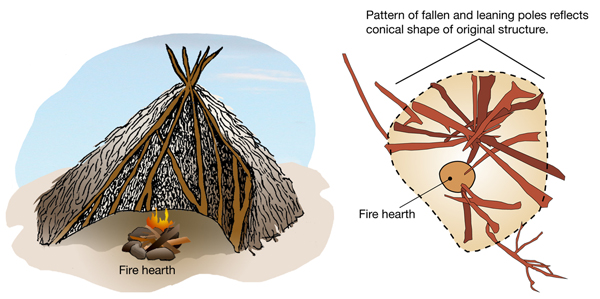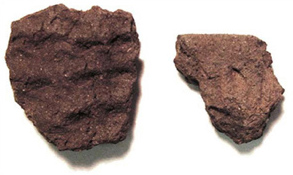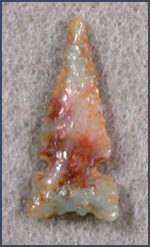Peoples of the Mesa Verde Region
The Post-Pueblo Period: A.D. 1300 to Late 1700sUte
The arrival of the Ute Indians in the Southwest has intrigued scholars for many years. Relying on linguistic (language) and archaeological evidence, researchers have attempted to reconstruct when these mobile hunter-gatherers first entered present-day Colorado. The Ute language is part of a widespread language family, called "Numic," that many researchers believe originated in southeastern California. Starting around A.D. 1000, Numic speakers spread across present-day Nevada and Utah, eventually reaching western Colorado. Archaeological evidence (mostly pottery) suggests that the Utes may have been living in western Colorado north of the Mesa Verde region by the 1400s, and possibly earlier. 
Early Ute wickiup. Left: What a wickiup might have looked like when in use. Right: The same wickiup as an archaeologist might find it hundreds of years later. How long have the Ute people lived in the Mesa Verde region specifically? The archaeological evidence is unclear. Chronicles written during the first Spanish explorations prove that Utes were living in the Mesa Verde region in the middle to late 1700s, but they undoubtedly had already been living there for some time. Some Utes today believe that their people have always lived in the region, and the fact that they have no migration stories describing how they came to be in the area is consistent with that belief. What they do have are origin stories, and those stories relate how the Ute people originated in the mountains of present-day Colorado and Utah. The Bear Dance, too, emphasizes the Ute's strong ties to the mountains. Still performed today, this important annual ceremony may have very ancient origins. 
Early Utes made very plain, utilitarian brown ware pottery. (See enlarged photograph.) The early Utes traveled in bands, hunting game and gathering wild plants and living in seasonal camps. Their mobile lifestyle required shelters that could be easily dismantled and tools and other equipment that could be packed up and moved. Although their lifeway produced few archaeological remains, archaeologists have found evidence of brush shelters (such as wickiups), as well as brown ware pottery and stone projectile points. These remains are similar to, and easily confused with, remains left by other hunter-gatherers who lived over time in the Mesa Verde region. 
This stone projectile point, typical of points used by early Utes, would have been hafted to the end of a wooden arrow shaft. (See enlarged photograph.) One of the most significant developments of the Post-Pueblo period—one that was to have an enormous effect on American Indians—was the introduction of the horse. Ute Indians had acquired horses from the Spanish by the late 1630s or early 1640s, and by the 1650s, they were using packhorses as well as dog travois to transport their goods. By the late 1600s, Ute Indians from the Mesa Verde region were traveling on horseback to trade with Pueblo Indians and Spaniards at Taos Pueblo in New Mexico. Visit the Ute Mountain Ute Web site to learn more about the Bear Dance. |
|
Acknowledgments | Illustration credits | To borrow, cite, or request permission | Please take our survey! Title page for Peoples of the Mesa Verde Region |
|
 DONATE TODAY
DONATE TODAY
